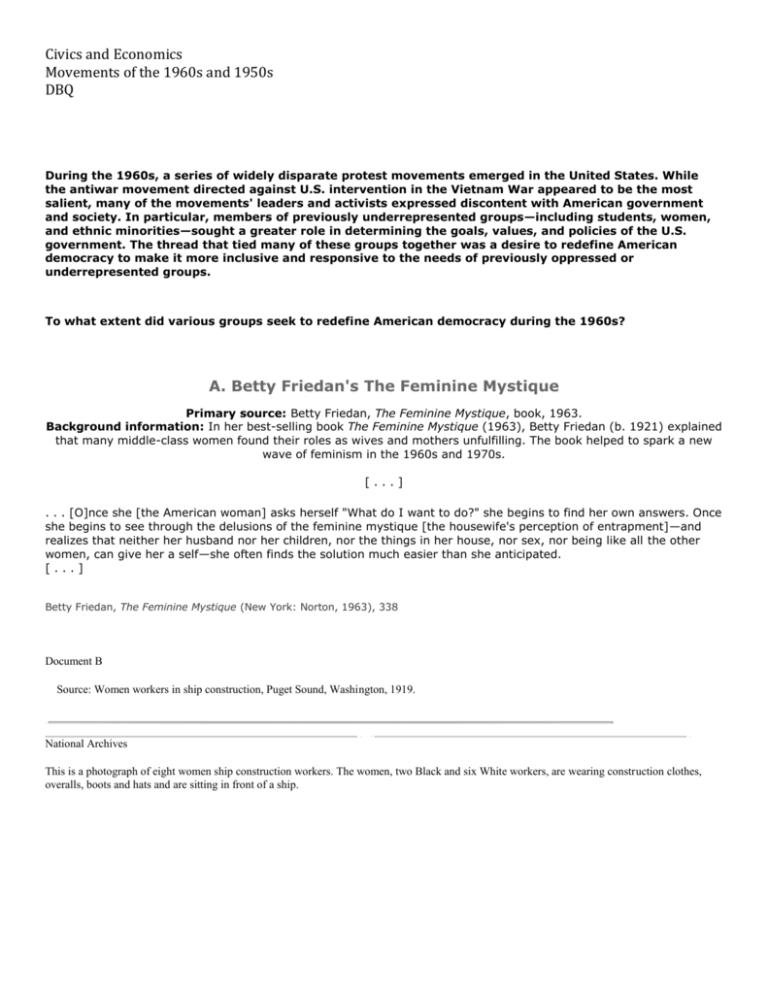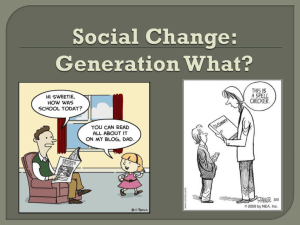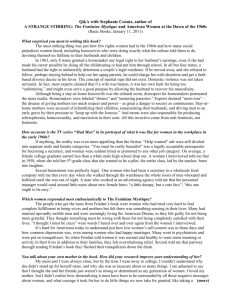DBQ
advertisement

Civics and Economics Movements of the 1960s and 1950s DBQ During the 1960s, a series of widely disparate protest movements emerged in the United States. While the antiwar movement directed against U.S. intervention in the Vietnam War appeared to be the most salient, many of the movements' leaders and activists expressed discontent with American government and society. In particular, members of previously underrepresented groups—including students, women, and ethnic minorities—sought a greater role in determining the goals, values, and policies of the U.S. government. The thread that tied many of these groups together was a desire to redefine American democracy to make it more inclusive and responsive to the needs of previously oppressed or underrepresented groups. To what extent did various groups seek to redefine American democracy during the 1960s? A. Betty Friedan's The Feminine Mystique Primary source: Betty Friedan, The Feminine Mystique, book, 1963. Background information: In her best-selling book The Feminine Mystique (1963), Betty Friedan (b. 1921) explained that many middle-class women found their roles as wives and mothers unfulfilling. The book helped to spark a new wave of feminism in the 1960s and 1970s. [...] . . . [O]nce she [the American woman] asks herself "What do I want to do?" she begins to find her own answers. Once she begins to see through the delusions of the feminine mystique [the housewife's perception of entrapment]—and realizes that neither her husband nor her children, nor the things in her house, nor sex, nor being like all the other women, can give her a self—she often finds the solution much easier than she anticipated. [...] Betty Friedan, The Feminine Mystique (New York: Norton, 1963), 338 Document B Source: Women workers in ship construction, Puget Sound, Washington, 1919. National Archives This is a photograph of eight women ship construction workers. The women, two Black and six White workers, are wearing construction clothes, overalls, boots and hats and are sitting in front of a ship. Document C Source: Edward A. Ross, The Social Trend, 1922. “When with spinning, weaving, knitting, churning, pickling, curing and preserving, the home was a workshop, the wife was not “supported” by her husband. He knew the value of her contribution and took her seriously, even if he did belittle her opinions on politics and theology. But, with the industrial decay of the home, it is more and more often the case that the husband “supports” his wife. How will the case appear in the eyes of the wife? As the woman of leisure realizes that everything she eats, wears, enjoys, and gives away comes out of her husband’s earnings, her rising impulse to assert herself as his equal is damped by consciousness of her abject economic dependence. She is tempted to pay for support with subservience, to mold her manner and her personality to his liking, to make up to him by her grace and charm for her exemption from work.” DOCUMENT D: George Wallace’s 1963 Inaugural Address as Governor of Alabama 2. According to this document, what is one of George Wallace’s intentions as Alabama governor? “… Today I have stood, where once Jefferson Davis stood, and took an oath to my people. It is very appropriate then that from this Cradle of the Confederacy, this very Heart of the Great Anglo-Saxon Southland, that today we sound the drum for freedom as have our generations of forebears before us done, time and time again through history. Let us rise to the call of freedom-loving blood that is in us and send our answer to the tyranny that clanks its chains upon the South. In the name of the greatest people that have ever trod this earth, I draw the line in the dust and toss the gauntlet before the feet of tyranny… and I say… segregation today…. Segregation tomorrow… segregation forever….” __________________________________________________________________________________. __________________________________________________________________________________. DOCUMENT E: 1976, Boston City Hall, Stanley Forman Photograph The photograph depicts a white teenager, Joseph Rakes, about to assault black lawyer and civil-rights activist Ted Landsmark with a flagpole bearing the American flag. It was taken in Boston on April 5, 1976, during a protest against court-ordered desegregation busing. Courtesy of www.stanleyformanphotos.com 10. What does this photograph indicate about the reactions to busing for school integration in Boston? __________________________________________________________________________________. __________________________________________________________________________________. DOCUMENT F: U.S. Congress, Civil Rights Act, federal law, 1964. Civil Rights Act of 1964: Long Title: To enforce the constitutional right to vote, to confer jurisdiction upon the district courts of the United States to provide relief against discrimination in public accommodations, to authorize the Attorney General to institute suits to protect constitutional rights in public facilities and public education, to extend the Commission on Civil Rights, to prevent discrimination in federally assisted programs, to establish a Commission on Equal Employment Opportunity, and for other purposes. . . . All persons shall be entitled to the full and equal enjoyment of the goods, services, facilities, and privileges, advantages, and accommodations of any place of public accommodation, as defined in this section, without discrimination or segregation on the ground of race, color, religion, or national origin. . . . Whenever the Attorney General has reasonable cause to believe that any person or group of persons is engaged in a pattern or practice of resistance to the full enjoyment of any of the rights secured by this title, and that the pattern or practice is of such a nature and is intended to deny the full exercise of the rights herein described, the Attorney General may bring a civil action in the appropriate district court of the United States by filing with it a complaint . . . requesting such preventive relief, including an application for a permanent or temporary injunction, restraining order or other order against the person or persons responsible for such pattern or practice, as he deems necessary to insure the full enjoyment of the rights herein described. 6. According to Document 6, what are two major legal changes made by the Civil Rights Act? __________________________________________________________________________________________________. __________________________________________________________________________________________________. G. Miranda Decision Primary source: U.S. Supreme Court, Miranda v. Arizona, Supreme Court decision, 1966. Background information: In Miranda v. Arizona (1966), the U.S. Supreme Court ruled that law-enforcement officials are required to inform the accused of their legal rights. [...] Mr. Chief Justice Warren delivered the opinion of the Court. The cases before us raise questions which go to the roots of our concepts of American criminal jurisprudence: the restraints society must observe consistent with the Federal Constitution in prosecuting individuals for crime. More specifically, we deal with the admissibility of statements obtained from an individual who is subjected to custodial police interrogation and the necessity for procedures which assure that the individual is accorded his privilege under the Fifth Amendment to the Constitution not to be compelled to incriminate himself.... [...] Our holding . . . briefly stated . . . is this: the prosecution may not use statements, whether exculpatory or inculpatory, stemming from custodial interrogation of the defendant unless it demonstrates the use of procedural safeguards effective to secure the privilege against self-incrimination.... [...] H. Robert F. Kennedy Runs for President Primary source: Robert F. Kennedy, announcement of his candidacy for the Democratic nomination for president, speech, 1968. Background information: Many Americans who supported President Johnson's (1908–73) domestic policy, which included the War on Poverty, were critical of the president's decision to escalate U.S. involvement in the Vietnam War. As antiwar sentiment grew, Robert F. Kennedy (1925–68), U.S. senator from New York, announced that he would run against President Johnson for the Democratic nomination for president in 1968. In his speech he addressed the nation's domestic problems and appealed to African Americans, Latinos, women, and the poor. [...] I do not run for the Presidency merely to oppose any man, but to propose new policies. I run because I am convinced that this country is on a perilous course and because I am obliged to do all I can. I run to seek new policies—policies to end the bloodshed in Vietnam and in our cities, policies to close the gaps between black and white, rich and poor, young and old, in this country and around the world.... [...] As a member of the Cabinet and a member of the Senate I have seen the inexcusable and ugly deprivation which causes children to starve in Mississippi, black citizens to riot in Watts, young Indians to commit suicide on their reservations because they lack all hope and they feel they have no future, and proud, able-bodied families to wait our their lives in empty idleness in Eastern Kentucky. I have traveled and listened to the young people of our Nation and felt their anger about the war they are sent to fight and the world they are about to inherit.... [...] Robert F. Kennedy's announcement of his candidacy for the Democratic nomination for president, Washington Post, 17 March 1968, p. A6. Full text is at http://www.rfkmemorial.org/RFK/68_announcement.htm. Document I: American Indians Occupy Alcatraz Primary source: Indians of All Tribes, "Proclamation: To the Great White Father and All His People," statement, 1969. Background information: In 1968, American Indians claiming a long history of oppression at the hands of white Americans organized the American Indian Movement (AIM). AIM and other groups staged a series of actions to further their cause. From 1969 to 1971, the organization Indians of All Tribes occupied the abandoned federal penitentiary on Alcatraz Island. In the proclamation excerpted here they explain their reasons. To the Great White Father and All His People: We, the native Americans, re-claim the land known as Alcatraz Island in the name of all American Indians by right of discovery. . . . We feel that this so-called Alcatraz Island is more than suitable for an Indian Reservation, as determined by the white man's own standards. By this we mean that this place resembles most Indian reservations in that: 1. 2. 3. 4. 5. 6. It is isolated from modern facilities, and without adequate means of transportation. It has no fresh running water. The sanitation facilities are inadequate. There are no oil or mineral rights. There is no industry and so unemployment is very great. There are no health care facilities.... [...] Further, it would be fitting and symbolic that ships from all over the world, entering the Golden Gate [at San Francisco harbor], would first see Indian land, and thus be reminded of the true history of this nation. This tiny island would be a symbol of the great lands once ruled by free and noble Indians. [...] Indians of All Tribes, "Proclamation: To the Great White Father and All His People" (November 1969), reprinted in Troy R. Johnson, The Occupation of Alcatraz Island: Indian Self-Determination and the Rise of Indian Activism (Urbana and Chicago: University of Illinois Press, 1996), 53–5 Doc: J Second Annual Address to the Public of the Lake Mohonk Conference 1st. Resolved, That the organization of the Indians in tribes is, and has been, one of the most serious hindrances to the advancement of the Indian toward civilization, and that every effort should be made to secure the disintegration of all tribal organizations; that to accomplish this result the Government should . . . cease to recognize the Indians as political bodies or organized tribes. . . . 4th. Resolved, That all adult male Indians should be admitted to the full privileges of citizenship by a process analogous to naturalization, upon evidence presented before the proper court of record of adequate intellectual and moral qualifications. . . . 6th. Resolved, That . . . our conviction has been strengthened as to importance of taking Indian youth from the reservations to be trained in industrial schools placed among communities of white citizens. . . . 14th. Resolved, That immediate efforts should be made to place the Indian in the same position before the law as that held by the rest of the population. This is an excerpt from the Second Annual Address to the Public of the Lake Mohonk Conference in Philadelphia, 1884, 3–7, 13–22. Document K Curtis Williams, Earth Angel (Will You Be Mine),1954. (performed by the Penguins) Words and music by Jesse Belvin, Gaynel Hodge and Curtis Williams The Penguins, Earth Angel, 1990Ý AceÝ(u.k.) http://www.lyricscafe.com/n/neville_aaron/045.htm "Earth Angel" by The Penguins, recorded in September 1954 and released on the DooTone label, has sold in the millions over the last 45 years and is still one of the most popular records of all time. It is a classical example of 1950s "bubblegum pop."As you listen to the rest of the songs in the DBQ, use this as a point of comparison. Notice how the folk and rock music of the 1960s differs, or does not differ, from this in both style and content. As you listen, notice both the melody and the lyrics. Earth Angel: 28.8, 56K Earth angel, earth angel, will you be mine? My darling girl, love you all the time. Im just a fool, a fool in love with you. Earth angel, earth angel, the one I adore. Love you forever, and ever more. Im just a fool, a fool in love with you. I fell for you and I knew The vision of your loveliness. I hope and I pray that one day Ill be the vision of your happiness. Repeat Document L Pete Townsend, My Generation, 1965 (performed by The Who) http://www.landoflyrics.com/music/thewho/lyrics/song1-5.htm The Who Sings My Generation, 1965Ý Decca/MCAÝ ©TRO-Devon Music, Inc. (BMI)Ý The Who, like the Beatles, were a young British band who invaded America in the mid-1960s. There music was labelled "mod rock" by some, "Maximum R&B" by others, and was characterized by the powerful guitar licks of Pete Townsend, the energetic singing of Roger Daltrey, the R&B inspired bas of John Entwistle and the ruthless drums of Keith Moon. Townshend's original material fused Beatlesque hooks and power chords with anthemic mod lyrics This track is off their first album. As you listen, notice the energy, and also notice how the Who depict their generation. My Generation: 28.8, 56K People try to p-put us down (Talkin bout my generation) Just because we get around (Talkin bout my generation) Things they do look awful c-cold (Talkin bout my generation) Hope I die before I get old (Talkin bout my generation) Its my generation. Its my generation, baby. Why dont you all f-fade away (Talkin bout my generation) Dont try to dig what we all s-say (Talkin bout my generation) Im not trying to cause a big sensation Im just talkin bout my generation My generation. This is my generation, baby. Repeat Document M Crosby, Stills, Nash and Young, 'Ohio' and 'Southern Man' from the album "Four Way Street," 1970 Crosby, Stills, Nash and Young, Four Way Street, 1992, Atlantic Records Words and Music © Neil Young, 1970 http://www.univie.ac.at/Anglistik/easyrider/data/4waystreet.htm In 1970, Crosby, Stills, Nash & Young were on the road in the U.S. and heading for Europe. On May 4th national guardsmen shot four students ay Kent State University, prompting ìOhio.î This song was a departure from the the naivitÈ that had been the hallmark of the group. Similarly, "Southern Man," a song challenging southern racism embraced a political and social controversy head-on. (The song provoked a response from the band Lynyrd Skynyrd in ìSweet Home Alabamaî[1974]: ìI hope Mr. Young will remember / A Southern man donít need him around, anyhowî). Ohio Tin soldiers and Nixon's coming, we're finally on our own. This summer I hear the drumming, four dead in Ohio. Gotta get down to it, soldiers are cutting us down. Should have been done long ago. What if you knew her and found her dead on the ground? How can you run when you know? repeat Four dead in Ohio, four dead in Ohio, four dead in Ohio, how many more? Four dead in Ohio, four dead in Ohio, four dead in Ohio, home many more? Southern Man Southern man, better keep your head, Don't forget what your good books said, Southern change gonna come at last. Now your crosses are burning fast, Southern man. I saw cotton and I saw black, Tall white mansions and little shacks, Southern man, when will you pay them back, I heard screaming and bull whips cracking How long? How long? Lillie Bell, your hair is golden brown, I've seen your mad man comin' round, I swear by God I'm gonna cut him down, I heard screaming and bull whips cracking, How long? How long?











